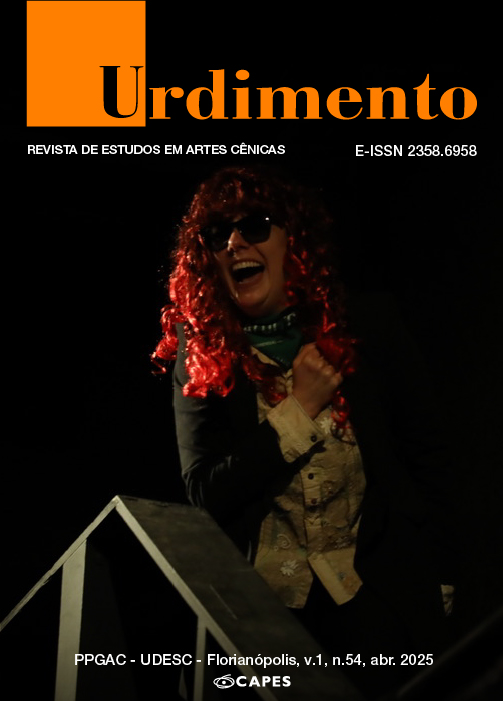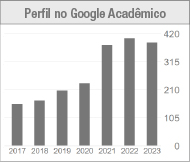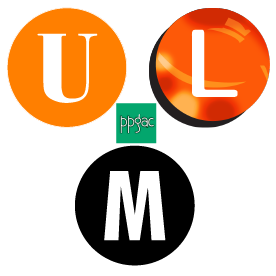A pedagogy for narrator actors: creative practices and strategies
DOI:
https://doi.org/10.5965/1414573101542025e104Keywords:
actor Narrator, epic-narrative practices, model actionAbstract
This paper presents epic-narrative strategies for theatrical performance, based on a teaching experience with the Actor Narrator curricular component in the Theater Degree course at the Federal Institute of Ceará (IFCE), a component whose program is inspired by Brecht's aesthetic-pedagogical project with learning plays. This text analyzes these strategies in two exercises focused on discovering principles for creating a community of actors as co-fabulators. As a third experience, the study of the adaptation of A Man’s A Man with students is reported, taking the text as a model of action, in order to reflect on a possible pedagogy for narrator actors.
Downloads
References
BENJAMIN, Walter. Que é o teatro épico? Um estudo sobre Brecht. In: Magia e técnica, arte e política: ensaios sobre literatura e história da cultura. São Paulo: Editora Brasiliense, 1987.
BRECHT, Bertolt. Estudos sobre teatro. Trad. Fiama Pais Brandão. Rio de Janeiro: Nova Fronteira, 2005.
BRECHT, Bertolt. Poemas (1913-1956). Seleção e tradução de Paulo César de Souza. São Paulo: Ed. 34, 2000.
BRECHT, Bertolt. Sobre a profissão do ator. Org. Werner Hecht. Trad., introdução e notas: Laura Brauer e Pedro Mantovani. São Paulo: Editora 34, 2022.
BRECHT, Bertolt. Um homem é um homem. Trad. Fernando Peixoto. Rio de Janeiro: Paz e Terra, 1987, vol. 2.
CONCILIO, Vicente. “Sete vezes Sr. Schmitt”: o modelo de ação e o jogo da encenação com a peça didática de Bertolt Brecht. Urdimento - Revista de Estudos em Artes Cênicas, Florianópolis, v. 2, n. 17, p. 157–163, 2011. DOI: 10.5965/1414573102172011157. Acesso em: 03 fev. 2025.
CONCILIO, Vicente; KOUDELA, Ingrid Dormien. Protocolos e a Pedagogia do Teatro – da tradução dos protocolos de estudantes sobre Aquele que diz sim aos protocolos do “trabalho alegre”. Urdimento - Revista de Estudos em Artes Cênicas, Florianópolis, v. 1, n. 34, p. 246–255, 2019. DOI: 10.5965/1414573101342019246. Acesso em: 03 fev. 2025.
COSTA, Iná Camargo. Nem uma lágrima, teatro épico em perspectiva dialética. São Paulo: Expressão popular, 2012.
GATTI, Luciano. A peça de aprendizagem: Heiner Müller e o modelo brechtiano. São Paulo: Perspectiva, 2015.
KOUDELA, Ingrid Dormien. Brecht: um jogo de aprendizagem. São Paulo: Perspectiva, 1991.
KOUDELA, Ingrid Dormien. Um vôo brechtiano: teoria e prática da peça didática. São Paulo: Perspectiva, 1992.
KOUDELA, Ingrid Dormien. A encenação contemporânea como prática pedagógica Urdimento - Revista de Estudos em Artes Cênicas, Florianópolis, v. 1, n. 10, p. 045–054, 2008. Disponível em:
https://revistas.udesc.br/index.php/urdimento/article/view/1414573101102008045 Acesso em: 22 jan. 2025.
KEISERMAN, N. W. Ator rapsodo: para uma linguagem gestual. Sinais de Cena, [S. l.], p. 81–85, 2011. DOI: 10.51427/cet.sdc.2011.0017. Acesso em: 22 jan. 2025.
LAMANNO-ADAMO, Vera L. C. Desejas a imortalidade? Ide (São Paulo), São Paulo, v. 42, n. 70, p. 237-244, dez. 2020. Disponível em http://pepsic.bvsalud.org/scielo.php?script=sci_arttext&pid=S0101-31062020000200022&lng=pt&nrm=iso. Acesso em: 12 dez. 2024.
SARRAZAC, Jean-Pierre. Trad. José Ronaldo Faleiro e Stephan Baumgartel. A Partilha das vozes. Urdimento - Revista de Estudos em Artes Cênicas, Florianópolis, v. 1, n. 20, p. 017–019, 2013. DOI: 10.5965/1414573101202013017. Acesso em: 10 fev. 2025.
STEINWEG, R. Das Lehrstück. Brechts Theorie einer politisch-ästhetischen Erziehung. Stuttgart: Metzler, 1972.
TEIXEIRA, F. N. Diga que você está de acordo!: o Material Fatzer de Brecht como modelo de ação. 2013. 324f. Tese (Doutorado em Artes Cênicas) - Universidade Federal da Bahia, Salvador, 2013. Disponível em: http://www.repositorio.ufba.br/ri/handle/ri/12469.
Published
How to Cite
Issue
Section
License
Copyright (c) 2025 Urdimento: Revista de Estudos em Artes Cênicas

This work is licensed under a Creative Commons Attribution 4.0 International License.
Copyright Statement
The articles published by the magazine are free to use. The copyright is all assigned to the magazine. The articles whose authors are identified represent the expression from the point of view of their authors and not the official position of the journal Urdimento. The author (s) undertakes whenever publishing material relating to the article published in Revista Urdimento mention the said publication as follows: This article was originally published by Urdimento magazine in its volume (put the volume), number (put the number) in the year of (put the year) and can be accessed at:
http://www.revistas.udesc.br/index.php/urdimento
This work is licensed under a Creative Commons Attribution 4.0 International License.




